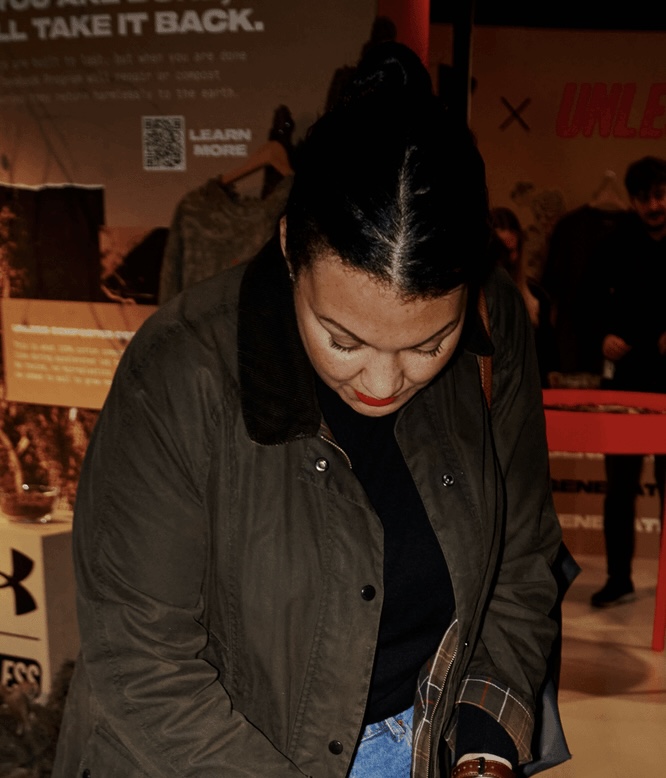What We’re Tracking: Brutalist Pep-Talks
Generally speaking, my writing lives in thresholds: the moment just prior to definition. I adore studying things mid-formation. This week, we’re tracking Brutalist Pep-Talks: big-type, one-line mantras turning city walls into coaches. Share-first objects that double as rules for living. The brief: seven words or fewer. Tie it to a ritual. Make the next step obvious.
Single-line, high-contrast typographic proclamations that externalise the inner coach or kitchen-table joke into public space. They don’t “advertise”; they declare, turning walls into mantras you can screenshot, repeat, and join.
At the 2025 Chicago marathon, Nike skipped the hard sell and lined the route with blunt, runner-coded mantras, the kind you mutter at mile 22. No product, no celebrities, just big type and tough love, engineered for a passing glance and a phone camera. It reads less like advertising than field support: short lines, long miles, perfectly fluent in the sport’s private jokes.
Patterns
- City as locker room: Second-person imperatives (“Shut up, brain.”) act like sideline bark, short, sweaty, memorable.
- Brutalist form, maximal voice: Plain backgrounds, big sans, no garnish. The copy is the creative.
- Share-first objects: Built to be photographed, memed, and recited, performance copy for the feed.

Origins
Short answer: it’s a mash-up of old-school poster minimalism and the social era’s need for meme-ready lines.
Longer answer:
- The Economist red posters (AMV BBDO, ’90s–’00s): single-line, high-contrast, ruthless wit. Clear ancestor of “copy is the creative.”
- Barbara Kruger / street slogan culture: declarative uppercase type on blocks of colour; the wall as a shouting surface.
- Swiss/International Typographic Style → graphic brutalism: grid, sans, no ornament. The message is the design.
- Wieden+Kennedy’s Nike voice: imperatives as coaching (“Just Do It”) - today’s “Shut up, brain.” Locker-room pep talk in public.
- British reclassification humour: Economist/Marmite/Innocent DNA ,simple rules that reframe behaviour (Waitrose’s kebab line from the summer).
Why it’s back now: attention is scarce, algorithms flatten nuance, and people want portable rules/permission. Big type + one line = instant mantra, easy UGC, zero context needed. Hence: Brutalist Pep-Talks.
Certainty beats nuance in scrollers’ peripheral vision. People want portable rules (mantras) and micro-permission to belong: run harder, grill anything, keep moving. These lines supply both, fast.
Potential
Brutalist Pep-Talks turn walls, cups, and screens into short, shouty mantras people adopt, not ads they ignore. The trick is one line, one behaviour, one payoff.
For Pret, that could mean coaching the morning ritual in places you can hold: cup sleeves, door vinyl, A-boards. “First sip, then decisions.” or “Emails after espresso.” sits on the sleeve; a sub-line invites action,“Order ahead. Skip the queue.”
For a brand like Monzo, the same move could shift from caffeine to control. “Make money behave” or “Save like you mean it.” Empty-state microcopy “Holiday, houseplant, house -add a goal and we’ll keep you on track”
Warburtons could have fun making it industrial-poetic at their new sourdough site, factory hoardings, delivery lorries, bakery doors. “Time does the heavy lifting.” or “Patience, then crust.” turns process into pride; a sub-line explains the craft, “Long ferment. British flour. Daily baked.” In-store endcaps echo it with a tactile cue: “Tap the loaf. Hear the work.”
Same pattern, different rituals: Pret coaches the day, Monzo coaches your money, Warburtons coaches your table. One bold line, a human promise, and the next step within arm’s reach.
Process
- Write for seven words or fewer; speakable in one breath.
- Tie to a specific ritual (mile 22, backyard skewer night).
- Let the context do half the work (placements near tracks, parks, markets).
Judge success by recitation and repeat use: do people quote the line, and does the next tap deliver? Keep that promise on loop and the work stops reading like advertising.










